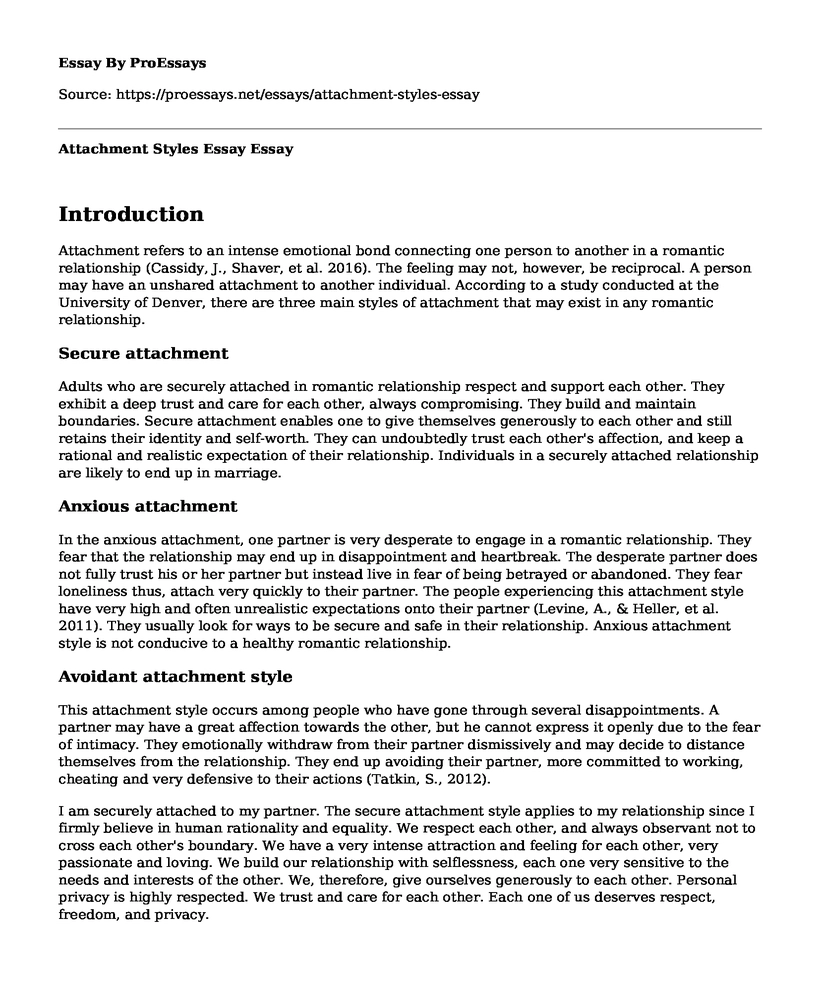Introduction
Attachment refers to an intense emotional bond connecting one person to another in a romantic relationship (Cassidy, J., Shaver, et al. 2016). The feeling may not, however, be reciprocal. A person may have an unshared attachment to another individual. According to a study conducted at the University of Denver, there are three main styles of attachment that may exist in any romantic relationship.
Secure attachment
Adults who are securely attached in romantic relationship respect and support each other. They exhibit a deep trust and care for each other, always compromising. They build and maintain boundaries. Secure attachment enables one to give themselves generously to each other and still retains their identity and self-worth. They can undoubtedly trust each other's affection, and keep a rational and realistic expectation of their relationship. Individuals in a securely attached relationship are likely to end up in marriage.
Anxious attachment
In the anxious attachment, one partner is very desperate to engage in a romantic relationship. They fear that the relationship may end up in disappointment and heartbreak. The desperate partner does not fully trust his or her partner but instead live in fear of being betrayed or abandoned. They fear loneliness thus, attach very quickly to their partner. The people experiencing this attachment style have very high and often unrealistic expectations onto their partner (Levine, A., & Heller, et al. 2011). They usually look for ways to be secure and safe in their relationship. Anxious attachment style is not conducive to a healthy romantic relationship.
Avoidant attachment style
This attachment style occurs among people who have gone through several disappointments. A partner may have a great affection towards the other, but he cannot express it openly due to the fear of intimacy. They emotionally withdraw from their partner dismissively and may decide to distance themselves from the relationship. They end up avoiding their partner, more committed to working, cheating and very defensive to their actions (Tatkin, S., 2012).
I am securely attached to my partner. The secure attachment style applies to my relationship since I firmly believe in human rationality and equality. We respect each other, and always observant not to cross each other's boundary. We have a very intense attraction and feeling for each other, very passionate and loving. We build our relationship with selflessness, each one very sensitive to the needs and interests of the other. We, therefore, give ourselves generously to each other. Personal privacy is highly respected. We trust and care for each other. Each one of us deserves respect, freedom, and privacy.
Avoidant and anxious attachments do not match my attitudes and values in dealing with romantic relationships. People in these attachment styles are driven by fear, control, and selfishness, thereby, draining their partner so much that they fail to maintain their identity. They concentrate on weaknesses and feelings of numerous unmet needs. Instead of empowering each other, individuals involved in these attachments are emotionally drained and dissatisfied. Anxious and avoidant attachments rarely show real love. They are prone to fail and break up into remorseful disappointments.
Secure attachment is driven by the selfless love which brings healing, enjoyment, and satisfaction (Zangar, K. R. 2013). People involved in this attachment style usually are more likely to get married to each other. Anxious and avoidant attachments, on the other hand, are driven by the selfish love which generally leads to disappointments, frustrations, lack of focus and regrets. They often end up in remorseful disappointments and breakups.
References
Cassidy, J., Shaver, P. R., & Guilford Press. (2016). Handbook of attachment: Theory, research, and clinical applications. New York: The Guilford Press.
Levine, A., & Heller, R. (2011). Attached: Identify your attachment style and find your perfect match.
Tatkin, S. (2012). Wired for Love: How understanding your partner's brain and attachment style can help you defuse conflict and build a secure relationship. Oakland, CA: New Harbinger Publications.
Zangar, K. R. (2013). No strings attached: Adult attachment styles in friends with benefits relationship.
Cite this page
Attachment Styles Essay. (2022, Jun 17). Retrieved from https://proessays.net/essays/attachment-styles-essay
If you are the original author of this essay and no longer wish to have it published on the ProEssays website, please click below to request its removal:
- Articles Summary: The Problem with Self-Investigation in a Post-Truth Era and My Problem with George Orwell
- Essay on Middle-Eastern Ethnicity Recognition
- Role of Communication in Organization Essay Example
- Paper Example on Ethical-Legal Dilemma of Advanced Practice Nurses
- Essay Example on Social Media: Unlocking Effective Communication for Business Growth
- Essay on Gaining Insight into My Community: Examining Culture Based on Demographics
- Non-Verbal Rules: Key to Success in New Region - Essay Sample







